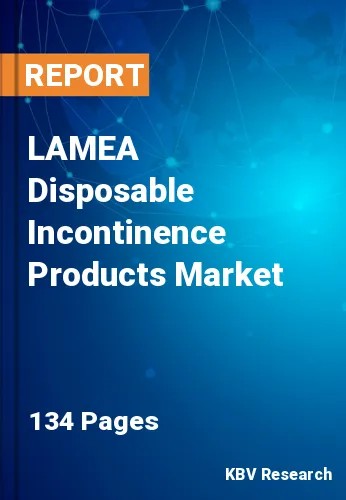The Latin America, Middle East and Africa Disposable Incontinence Products Market would witness market growth of 8.1% CAGR during the forecast period (2023-2030). In the year 2026, the LAMEA market's volume is expected to surge to 252.9 million units, showcasing a growth of 9.2% (2023-2030).
Odor control technologies have seen significant advancements, addressing a common concern associated with incontinence. Manufacturers incorporate specialized materials and treatments to minimize or neutralize odors, enhancing users' overall hygiene and confidence. Some manufacturers opt for scented options as part of their odor control strategy. Scented disposable incontinence products incorporate pleasant fragrances, creating a more positive and enjoyable user experience while masking potential odors.
In addition, developing discreet and low-profile designs is a notable innovation in products. Thin and lightweight solutions provide users with a more comfortable and inconspicuous experience while maintaining high absorbency levels. Manufacturers use soft and flexible materials in the construction of these products. This choice of materials enhances comfort, conforming to the body's natural contours and providing a more flexible and adaptive fit. The design incorporates body-conforming shapes that optimize the fit and minimize visibility under clothing. These shapes create a more natural and discreet appearance, making users feel confident and secure.
The population of UAE will witness an increase in the number of older people. There is a growing awareness of health and hygiene among the elderly and their caregivers. This increased awareness will likely drive the demand for it as people seek effective solutions to manage these conditions. According to the Dubai Statistics Center, senior citizens account for nearly 6.6% of Dubai's Emirati population. This percentage is expected to rise gradually based on the continuous increase of people's age & the development of health care services. Thus, with the rising elderly population in LAMEA, this will grow in the region.
The Brazil market dominated the LAMEA Disposable Incontinence Products Market, by Country in 2022, and would continue to be a dominant market till 2030; thereby, achieving a market value of $355.3 Million by 2030. The Argentina market is registering a CAGR of 8.6% during (2023 - 2030). Additionally, The UAE market would showcase a CAGR of 7.7% during (2023 - 2030).
Free Valuable Insights: The Worldwide Disposable Incontinence Products Market is Projected to reach USD 18.7 Billion by 2030, at a CAGR of 6.1%
Based on Incontinence Type, the market is segmented into Stress Urinary Incontinence, Urge Urinary Incontinence, Overflow Urinary Incontinence, and Functional Urinary Incontinence. Based on Product, the market is segmented into Disposable Diapers, Disposable Underwear, Disposable Shields, Disposable Underpads, and Others. Based on countries, the market is segmented into Brazil, Argentina, UAE, Saudi Arabia, South Africa, Nigeria, and Rest of LAMEA.
By Incontinence Type (Volume, Million Units, USD Billion, 2019-2030)
By Product (Volume, Million Units, USD Billion, 2019-2030)
By Country (Volume, Million Units, USD Billion, 2019-2030)
Our team of dedicated experts can provide you with attractive expansion opportunities for your business.

